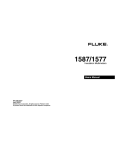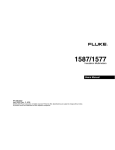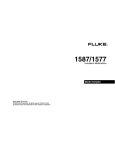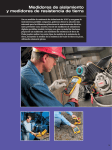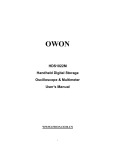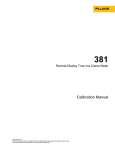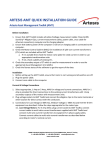Download 1587 FC/1587/1577
Transcript
1587 FC/1587/1577
Insulation Multimeter
Users Manual
April 2005 Rev.3, 9/15
© 2005-2015 Fluke Corporation. All rights reserved. Specifications are subject to change without notice.
All product names are trademarks of their respective companies.
LIMITED WARRANTY AND LIMITATION OF LIABILITY
Each Fluke product is warranted to be free from defects in material and workmanship under normal use and service. The warranty period is
three years and begins on the date of shipment. Parts, product repairs, and services are warranted for 90 days. This warranty extends only
to the original buyer or end-user customer of a Fluke authorized reseller, and does not apply to fuses, disposable batteries, or to any
product which, in Fluke's opinion, has been misused, altered, neglected, contaminated, or damaged by accident or abnormal conditions of
operation or handling. Fluke warrants that software will operate substantially in accordance with its functional specifications for 90 days and
that it has been properly recorded on non-defective media. Fluke does not warrant that software will be error free or operate without
interruption.
Fluke authorized resellers shall extend this warranty on new and unused products to end-user customers only but have no authority to
extend a greater or different warranty on behalf of Fluke. Warranty support is available only if product is purchased through a Fluke
authorized sales outlet or Buyer has paid the applicable international price. Fluke reserves the right to invoice Buyer for importation costs of
repair/replacement parts when product purchased in one country is submitted for repair in another country.
Fluke's warranty obligation is limited, at Fluke's option, to refund of the purchase price, free of charge repair, or replacement of a defective
product which is returned to a Fluke authorized service center within the warranty period.
To obtain warranty service, contact your nearest Fluke authorized service center to obtain return authorization information, then send the
product to that service center, with a description of the difficulty, postage and insurance prepaid (FOB Destination). Fluke assumes no risk
for damage in transit. Following warranty repair, the product will be returned to Buyer, transportation prepaid (FOB Destination). If Fluke
determines that failure was caused by neglect, misuse, contamination, alteration, accident, or abnormal condition of operation or handling,
including overvoltage failures caused by use outside the product’s specified rating, or normal wear and tear of mechanical components,
Fluke will provide an estimate of repair costs and obtain authorization before commencing the work. Following repair, the product will be
returned to the Buyer transportation prepaid and the Buyer will be billed for the repair and return transportation charges (FOB Shipping
Point).
THIS WARRANTY IS BUYER'S SOLE AND EXCLUSIVE REMEDY AND IS IN LIEU OF ALL OTHER WARRANTIES, EXPRESS OR
IMPLIED, INCLUDING BUT NOT LIMITED TO ANY IMPLIED WARRANTY OF MERCHANTABILITY OR FITNESS FOR A PARTICULAR
PURPOSE. FLUKE SHALL NOT BE LIABLE FOR ANY SPECIAL, INDIRECT, INCIDENTAL OR CONSEQUENTIAL DAMAGES OR
LOSSES, INCLUDING LOSS OF DATA, ARISING FROM ANY CAUSE OR THEORY.
Since some countries or states do not allow limitation of the term of an implied warranty, or exclusion or limitation of incidental or
consequential damages, the limitations and exclusions of this warranty may not apply to every buyer. If any provision of this Warranty is
held invalid or unenforceable by a court or other decision-maker of competent jurisdiction, such holding will not affect the validity or
enforceability of any other provision.
Fluke Corporation
Fluke Europe B.V.
P.O. Box 9090
P.O. Box 1186
Everett, WA 98206-9090
5602 BD Eindhoven
U.S.A.
The Netherlands
11/99
Table of Contents
Title
Page
Introduction ....................................................................................................................
Contacting Fluke ............................................................................................................
Safety Information..........................................................................................................
Unpack List ....................................................................................................................
Accessories ...................................................................................................................
Hazardous Voltage ........................................................................................................
Test Lead Alert ..............................................................................................................
Battery Saver (Sleep Mode) ..........................................................................................
Rotary Switch Positions .................................................................................................
Buttons ..........................................................................................................................
Display ...........................................................................................................................
Input Terminals ..............................................................................................................
Power-Up Options .........................................................................................................
AutoHold Mode ..............................................................................................................
MIN MAX AVG Recording Mode....................................................................................
Manual Ranging and Auto Ranging ...............................................................................
AC Zero Input Behavior of True RMS Meters ................................................................
VFD Low-Pass Filter (all 1587 Models) .........................................................................
i
1
2
2
5
5
6
6
6
7
9
11
14
15
16
16
17
17
17
1587 FC/1587/1577
Users Manual
Basic Measurements .....................................................................................................
AC and DC Voltage ...................................................................................................
Temperature (all 1587 Models) .................................................................................
Resistance ................................................................................................................
Capacitance (all 1587 models) ..................................................................................
Continuity ..................................................................................................................
Diodes (all 1587 models) ..........................................................................................
AC or DC Current ......................................................................................................
Insulation...................................................................................................................
Frequency (all 1587 Models) .....................................................................................
Fluke Connect™ Wireless System ............................................................................
How to Clean .................................................................................................................
Battery Test ...................................................................................................................
Fuse Test .......................................................................................................................
Battery and Fuse Replacement .....................................................................................
General Specifications ...................................................................................................
Electrical Specifications .................................................................................................
ii
18
19
20
21
21
22
23
24
26
28
30
31
31
31
32
33
35
List of Tables
Table
1.
2.
3.
4.
5.
6.
7.
8.
9.
10.
Title
Page
Symbols ................................................................................................................................
Unpack List ...........................................................................................................................
Accessories ..........................................................................................................................
Rotary Switch Selections ......................................................................................................
Buttons..................................................................................................................................
Display Indicators .................................................................................................................
Error Messages ....................................................................................................................
Input Terminal Descriptions ..................................................................................................
Power-Up Options ................................................................................................................
Fuse and Battery Replacement ............................................................................................
iii
4
5
5
7
9
11
14
14
15
32
1587 FC/1587/1577
Users Manual
iv
List of Figures
Figure
1.
2.
3.
4.
5.
6.
7.
8.
9.
10.
11.
12.
Title
Page
VFD Low Pass Filter .............................................................................................................
Measuring AC and DC Voltage .............................................................................................
Measuring Temperature........................................................................................................
Measuring Resistance ..........................................................................................................
Measuring Capacitance ........................................................................................................
Testing for Continuity ............................................................................................................
Testing Diodes ......................................................................................................................
Measuring AC or DC Current ................................................................................................
Testing Insulation ..................................................................................................................
Measuring Frequency ...........................................................................................................
Fluke Connect™ ...................................................................................................................
Testing the Fuse ...................................................................................................................
v
18
19
20
21
21
22
23
25
27
29
30
31
1587 FC/1587/1577
Users Manual
vi
Introduction
The Fluke 1587 FC, 1587, 1587T, and 1577 are
battery-powered, true-RMS insulation multimeters (the
Product or Meter) with a 6000-count display. Although this
manual describes the operation of all models, all
illustrations and examples assume use of Model 1587 FC.
The Meter measures or tests:
• AC / DC voltage and current
• Resistance
• Continuity
• Insulation resistance
• Voltage and current frequency
• Diodes (all 1587 models)
• Temperature (all 1587 models)
• Capacitance (all 1587 models)
The 1587 FC supports the Fluke Connect™ Wireless
System (may not be available in all regions). Fluke
Connect™ is a system that wirelessly connects your Meter
with an app on your smartphone or tablet. The app shows
the Meter measurement on your smartphone or tablet
screen. You can save these measurements with Fluke
Connect™ to share with your team.
More information about how to use Fluke Connect is on
page 30.
1
1587 FC/1587/1577
Users Manual
Contacting Fluke
Safety Information
To contact Fluke, call one of the following telephone
numbers:
A Warning identifies conditions and procedures that are
dangerous to the user. A Caution identifies conditions and
procedures that can cause damage to the Product or the
equipment under test. See Table 1 for a list of symbols
used on the Meter and in this manual.
•
Technical Support USA: 1-800-44-FLUKE
(1-800-443-5853)
•
Calibration/Repair USA: 1-888-99-FLUKE
(1-888-993-5853)
•
Canada: 1-800-36-FLUKE (1-800-363-5853)
•
Europe: +31 402-675-200
•
Japan: +81-3-6714-3114
•
Singapore: +65-6799-5566
•
Anywhere in the world: +1-425-446-5500
Or, visit Fluke’s website at www.fluke.com.
To register your product, visit http://register.fluke.com.
To view, print, or download the latest manual supplement,
visit http://us.fluke.com/usen/support/manuals.
2
Warning
To prevent possible electric shock, fire, or
personal injury:
• Read all safety information before you use
the Product
• Examine the case before you use the
Product. Look for cracks or missing
plastic. Carefully look at the insulation
around the terminals.
• Do not use test leads if they are damaged.
Examine the test leads for damaged
insulation and measure a known voltage.
• Do not use the Meter around explosive gas,
vapor, or in damp or wet environments.
• Do not touch voltages >30 V ac rms,
42 V ac peak, or 60 V dc.
• Only use probes, test leads, and
accessories that have the same
measurement category, voltage, and
amperage ratings as the Product.
Insulation Multimeter
Safety Information
•
•
•
•
•
•
•
•
Keep fingers behind the finger guards on
the probes.
Do not exceed the Measurement Category
(CAT) rating of the lowest rated individual
component of a Product, probe, or
accessory.
Use the Product only as specified, or the
protection supplied by the Product can be
compromised.
Comply with local and national safety
codes. Use personal protective equipment
(approved rubber gloves, face protection,
and flame-resistant clothes) to prevent
shock and arc blast injury where
hazardous live conductors are exposed.
Do not work alone.
Do not apply more than the rated voltage
between the terminals or between each
terminal and earth ground.
Limit operation to the specified
measurement category, voltage, or
amperage ratings.
Use Product-approved measurement
category (CAT), voltage, and amperage
rated accessories (probes, test leads, and
adapters) for all measurements.
•
•
•
•
•
•
•
•
•
•
Measure a known voltage first to make
sure that the Product operates correctly.
Use the correct terminals, function, and
range for measurements.
Measure for hazardous voltage without the
Low-Pass Filter.
Do not use the Product if it operates
incorrectly.
Replace the battery when the low battery
indicator () shows to prevent incorrect
measurements.
Remove the batteries if the Product is not
used for an extended period of time, or if
stored in temperatures >50 °C. If the
batteries are not removed, battery leakage
can damage the Product.
The battery door must be closed and
locked before you operate the Product.
Remove all probes, test leads, and
accessories before the battery door is
opened.
Do not use the Product if it is damaged.
Disable the Product if it is damaged.
3
1587 FC/1587/1577
Users Manual
Table 1. Symbols
Symbol
Symbol
Description
WARNING.RISK OF DANGER.
WARNING. HAZARDOUS VOLTAGE. Risk of electric
shock.
Consult user documentation.
Battery (Low battery when shown on display.)
AC (Alternating Current)
Earth
Double Insulated
Conforms to relevant Australian EMC standards.
Certified by CSA Group to North American safety
standards.
Conforms to European Union directives.
Certified by TÜV SÜD Product Service.
DC (Direct Current)
Fuse
Conforms to relevant South Korean EMC Standards.
Measurement Category II is applicable to test and measuring circuits connected directly to utilization points (socket outlets
and similar points) of the low-voltage MAINS installation.
Measurement Category III is applicable to test and measuring circuits connected to the distribution part of the building’s
low-voltage MAINS installation.
Measurement Category IV is applicable to test and measuring circuits connected at the source of the building’s low-voltage
MAINS installation.
4
Description
This product complies with the WEEE Directive marking requirements. The affixed label indicates that you must not discard
this electrical/electronic product in domestic household waste. Product Category: With reference to the equipment types in
the WEEE Directive Annex I, this product is classed as category 9 “Monitoring and Control Instrumentation” product. Do not
dispose of this product as unsorted municipal waste.
Insulation Multimeter
Unpack List
Unpack List
Accessories
Table 2 is a list of accessories included with your Product.
Table 3 is list of optional accessories that are available for
the Product.
Table 2. Unpack List
Table 3. Accessories
Model
Accessory
1587, 1587T, 1587 FC
1577
Leads
TL224
TL224
Probes
TP74
TL74
Clips
AC285
AC285
Holster
Yes
Yes
Hard Case
Yes
Yes
K Type
Thermocouple
Yes
No
Remote Probe
Yes
Yes
Accessory
Part Number
ToolPakTM Magnetic
Meter Hanger Kit
go to www.fluke.com/tpak
AC 400A Clamp
I400
5
1587 FC/1587/1577
Users Manual
Hazardous Voltage
To alert you to the presence of a potentially hazardous
voltage, when the Meter detects a voltage ≥30 V or a
voltage overload (), the Z symbol is displayed.
Test Lead Alert
To remind you to check that the test leads are in the
correct terminals, shows momentarily when you move
the rotary switch to or from the c position.
Warning
To prevent possible electric shock, fire, or
personal injury, use the correct terminals,
function, and range for measurements.
6
Battery Saver (Sleep Mode)
The Meter enters “Sleep mode” and blanks the display if
there is no function change or button press for 20 minutes.
This is done to conserve battery power. The Meter comes
out of Sleep mode when a key is pressed or when the
rotary switched is turned.
To disable Sleep mode, hold down the blue button while
you turn on the Meter. Sleep mode is always disabled in
the MIN MAX AVG recording mode, AutoHold mode, or
when the insulation test is active.
Insulation Multimeter
Rotary Switch Positions
Rotary Switch Positions
Turn the Meter on by selecting any measurement function.
The Meter presents a standard display for that function
(range, measurement units, modifiers, etc.). Use the blue
button to select any rotary switch alternate functions
(labelled with blue letters). Rotary switch selections are
shown and described in Table 4.
B
K
C
E
AC voltage from 30.0 mV to 1000 V.
AC voltage with 800 Hz VFD low-pass filter.
DC voltage 1 mV to 1000 V.
DC mV 0.1 mV to 600 mV.
•
•
•
•
•
•
•
•
• •
•
• •
• •
1577
Measurement Function
1587T
Switch
Position
1587
bav02f.eps
1587 FC
Table 4. Rotary Switch Selections
7
1587 FC/1587/1577
Users Manual
k
o
X
O
c
Temperature from - 40 °C to + 537 °C (- 40 °F to + 998 °F).
Celsius is the default temperature measurement unit. The temperature measurement you select is
retained in memory when the Meter is turned off.
• • •
Ohms from 0.1 Ω to 50 MΩ.
• • • •
Capacitance from 1 nF to 9999 μF.
• • •
Continuity test. Beeper turns on at <25 Ω and turns off at >100 Ω.
• • • •
Diode test. There is no ranging in this function. Displays above 6.600 V.
• • •
AC mA from 3.00 mA to 400 mA (600 mA overload for 2 minutes maximum).
DC mA from 0.01 mA to 400 mA (600 mA overload for 2 minutes maximum).
• • • •
Ohms from 0.01 MΩ to 2 GΩ. The last selected output voltage setting is retained in memory when the
Meter is turned off.
• • •
Ohms from 0.01 MΩ to 600 MΩ. The last selected output voltage setting is retained in memory when the
Meter is turned off.
a
INSULATION
Performs insulation test with:
50 V, 100 V, 250 V, 500 V (default), and 1000 V source
•
• •
500 V (default) and 1000 V source
50 V (default) and 100 V source
Press the blue button to activate smoothing during insulation testing.
8
1577
1587T
Measurement Function
1587
Switch
Position
1587 FC
Table 4. Rotary Switch Selections (cont.)
•
• • •
•
Insulation Multimeter
Buttons
Buttons
Use the buttons to activate features that augment the
function selected with the rotary switch. The buttons are
shown and described in Table 5.
Table 5. Buttons
1577
Description
1587T
Button
1587
bav03f.eps
1587 FC
SAVE
Press to freeze the displayed value. Press again to release the display.
When a reading changes, the display updates and the Meter beeps.
In Insulation Test mode, this schedules a test lock the next time you press on the Meter or on the
remote probe. The test lock acts to hold down the button until your press or again to release
the lock.
In MIN MAX AVG or Hz mode, this button is the display hold.
m
Press to start retaining maximum, minimum, and average values. Press successively to display maximum,
minimum, average, and present values. Press and hold to cancel MIN MAX AVG.
Activate frequency measurement.
Toggles between degrees C and degrees F.
• • • •
• • •
• • •
• • •
•
9
1587 FC/1587/1577
Users Manual
r
Changes Ranging mode from Auto (default) to Manual Ranging mode. Switches between available ranges
in a function. Press and hold to return to Auto Ranging mode.
G
Initiates an insulation test when the rotary switch is on the INSULATION position. Causes the Meter to
source (output) a high voltage and measure insulation resistance.
• • • •
The blue button functions as a shift key. Press to access blue functions on the rotary switch.
• • • •
Press to configure for PI mode, press again to configure for DAR mode.
•
The test starts when you press the .
10
1577
Turns the backlight on and off. The backlight goes off after two minutes.
• •
• • • •
Configures the Tester for a polarization index (PI) or dielectric absorption ratio test (DAR).
• • • •
In Insulation Test mode, switches between available source voltages.
Toggles between degrees C and degrees F.
H
1587T
Description
1587
Button
1587 FC
Table 5. Buttons (cont.)
•
Turn on the radio and set the Product to the module mode. shows in the display when the radio is
on.
•
When used with the Fluke Connect App on your smart device, saves a measurement to the Fluke
Connect app.
•
Press >2 s. to turn off the radio and exit the module mode.
•
Insulation Multimeter
Display
Warning
To prevent possible electric shock or personal
Display indicators are shown and described in Table 6.
injury, replace the battery when the low battery
Error messages that may appear on the display are
indicator () shows to prevent incorrect
described in Table 7.
measurements.
Table 6. Display Indicators
Display
1587 FC
1587
1587T
1577
Model
Low battery. Time to replace the battery. When is on, the backlight button is disabled to
conserve battery life. 1587 FC model: module mode is disabled when the battery is low.
•
•
•
•
Indicates a test lock will be applied the next time you press on the Meter or on the remote
probe. The test lock acts to hold down the button until you press or again.
•
•
•
•
Less than, minus, or greater than symbols
•
•
•
•
bav01f.eps
Indicator
L
LOCK
P
/
Q
Description
11
1587 FC/1587/1577
Users Manual
Indicator
Description
1587 FC
1587
1587T
1577
Table 6. Display Indicators (cont.)
Z
Hazardous voltage warning. Indicates 30 V or greater (ac or dc depending on the rotary
switch position) is detected on the input. Also appears when the display shows in the B, C,
or E switch positions, and when appears on the display. The Z also appears when
insulation test is active, or in Hz.
•
•
•
•
a
“Smoothing” enabled. Smoothing dampens display fluctuations of rapidly changing inputs by
digital filtering. Smoothing is available for insulation testing on 1587 models only. For more
on smoothing, see Power-Up Options.
•
•
•
K
Indicates the VFD low-pass filter function for ac volts is selected.
•
•
•
•
•
•
•
•
•
•
•
•
•
•
•
•
•
•
•
•
•
•
•
•
•
•
•
•
Y
S
M
n
X
O
nF, μF, ° C, ° F,
AC, DC, V, mV,
mA, Hz, kHz, Ω,
kΩ, MΩ, GΩ
12
Indicates AutoHold is active.
Indicates display hold is active.
Indicates minimum, maximum, or average reading has been selected using the € button.
Continuity test function is selected.
Diode test function is selected.
Measurement units.
0000
Primary display.
VDC
Volts source for Insulation test.
•
Insulation Multimeter
Display
1587 FC
1587
1587T
1577
Table 6. Display Indicators (cont.)
Secondary display for insulation test voltage.
•
•
•
•
Display range in use.
•
•
•
•
Source voltage rating for insulation test: 50, 100, 250, 500 (default) or 1000 V on the 1587.
500 (default) and 1000 V ranges available on the 1577. 50 (default) and 100 V on the
1587T.
•
•
•
•
•
•
•
•
•
•
Indicator
Auto Range
ManualRange
610000
2500V
1000V
Description
T
Insulation test indicator. Appears when insulation test voltage is present.
/
Shows the Product is in PI or DAR mode.
Shows that the radio is enabled.
ID#
When the Product is discovered by a Fluke Connect device, an ID number is shown on the
secondary display. The ID number also shows on the Fluke Connect device with the
Product’s model number.
•
13
1587 FC/1587/1577
Users Manual
Table 7. Error Messages
Message
Description
Appears on the primary display and indicates that
the battery is too low for reliable operation. The
Meter will not operate at all until the battery is
replaced. The also appears when is on
the primary display.
Appears on the secondary display and indicates
that the battery is too low to perform an insulation
test. The button is disabled until the battery
is replaced. This message disappears when the
rotary switch is turned to any other function.
Appears when an open thermocouple is detected.
Test lead alert. The message appears briefly and a
single beep will sound when you move the switch
in or out of the c position.
-
Input Terminals
Input terminals are shown and described in Table 8.
Table 8. Input Terminal Descriptions
.
3
2
4
bav04f.eps
Item
Description
Model detect error. Service Meter if this is
displayed.
p input terminal for insulation test.
Meter cannot discharge a capacitor.
q input terminal for insulation test. Use for ac and dc
milliamp measurements to 400 mA and current
frequency measurements.
Invalid EEProm data. Have the Meter serviced.
1577: input terminal for voltage, continuity, resistance
Invalid calibration data. Calibrate the Meter.
14
1
1587: input terminal for voltage, continuity, resistance,
diode, capacitance, voltage frequency, and
temperature measurements.
Common (return) terminal for all measurements except
insulation test.
Insulation Multimeter
Power-Up Options
Power-Up Options
Holding a button down while turning the Meter on activates
a power-up option. Power-up options allow you to use
additional features and functions of the Meter. To select a
power-up option, hold down the appropriate button
indicated while turning the Meter from OFF to any switch
position. Power-up options are cancelled when the Meter
is turned OFF. Power-up options are described in Table 9.
Note
Power Up options are active when the button is
pressed.
Table 9. Power-Up Options
Button
Description
B (V ac and mA ac) switch position turns on all LCD
segments.
C (V dc) switch position displays the software
version number.
E (mV) switch position displays the model number.
N(Ohms/Capacitance) switch position turns on the
S backlight and the radio LED.
F(Continuity/Diode) switch position starts the
Calibration Mode. The Meter shows and enters
the Calibration Mode when you release the button.
r
a
G
(Blue)
H
INSULATION switch position initiates a fully loaded
battery test and displays the charge level of the
battery until the button is released.
Enables “Smoothing” mode for all of the functions
except insulation. The display shows --- until the
button is released. Smoothing dampens display
fluctuations of rapidly changing inputs by digital
filtering.
Disables automatic power-off ("Sleep mode").
Display shows until you release the button.
Sleep mode is also disabled while the Meter is in a
MIN MAX AVG Recording mode, AutoHold mode,
and when performing an insulation test.
Disables the beeper. The display shows until
you release the button.
Disables the automatic backlight timeout. Display
shows until you release the button.
15
1587 FC/1587/1577
Users Manual
AutoHold Mode
Warning
To prevent electrical shock, do not use the
Display AutoHold mode to determine if a
circuit is live. Unstable or noisy readings will
not be captured.
The Meter tracks the minimum, maximum, and average
values for each display which are updated 4 times per
second.
To use MIN MAX AVG recording:
•
In the AutoHold mode, the Meter holds the reading on the
display until it detects a new stable reading. Then the
Meter beeps and displays the new reading.
Make sure the Meter is in the desired measurement
function and range. (Autoranging is disabled in the
MIN MAX AVG mode).
•
Press m to activate MIN MAX AVG mode.
M shows on the display.
•
•
Press m to step through the high (MAX), low (MIN),
average (AVG), and present readings.
•
To pause MIN MAX AVG recording without erasing
stored values, press . S shows on the
display.
•
To resume MIN MAX AVG recording, press
again. S turns off.
•
To exit and erase stored readings, press m for one
second or turn the rotary switch.
•
Press to activate AutoHold. Y shows on
the display.
Press again or turn the rotary switch to resume
normal operation.
MIN MAX AVG Recording Mode
The MIN MAX AVG mode records minimum and maximum
input values. The Meter beeps and records a new value
when the inputs go below the recorded minimum value, or
above the recorded maximum value. This mode can be
used to capture intermittent readings, record maximum
readings while you are away or record readings while you
are operating the equipment under test and cannot watch
the Meter. MIN MAX AVG mode can also calculate an
average of all readings taken since the MIN MAX AVG
mode was activated.
16
Insulation Multimeter
Manual Ranging and Auto Ranging
Manual Ranging and Auto Ranging
The Meter has both Manual Range and Auto Range
modes.
•
•
In the Auto Range mode, the Meter selects the range
with the best resolution.
In the Manual Range mode, you override Auto Range
and select the range yourself.
When you turn the Meter on, it defaults to Auto Range and
Auto Range is shown.
1. To enter the Manual Range mode, press r.
Manual Range is shown.
2. In the Manual Range mode, press r to increment
the range. After the highest range, the Meter wraps to
the lowest range.
Note
You cannot manually change the range in the MIN
MAX AVG, or Display HOLD modes.
If you press r while in MIN MAX AVG, or
Display HOLD the Meter beeps twice, indicating
an invalid operation and the range does not
change.
3. To exit Manual Range, press r for one second or
turn the rotary switch. The Meter returns to Auto
Range and Auto Range is shown.
AC Zero Input Behavior of True RMS
Meters
True RMS Meters accurately measure distorted
waveforms, but when the input leads are shorted together
in the AC functions, the Meter displays a residual reading
between 1 and 30 counts. When the test leads are open,
the display readings may fluctuate due to interference.
These offset readings are normal. They do not affect the
Meter’s ac measurement accuracy over the specified
measurement ranges.
Unspecified input levels are:
•
•
AC voltage: below 5 % of 600 mV ac, or 30 mV ac.
AC current: below 5 % of 60 mA ac, or 3 mA ac.
VFD Low-Pass Filter (all 1587 Models)
The 1587 is equipped with an ac low-pass filter to measure
the output of variable frequency motor drives (VFD). For
ac voltage or ac frequency (B) measurements, press the
blue button to activate the Low-Pass Filter function (K).
The Meter continues measuring in the selected ac mode,
but now the signal diverts through a filter that blocks
unwanted frequencies above 800 Hz. Refer to Figure 1.
The low pass filter can improve measurement performance
on composite sine waves that are typically generated by
inverters and variable frequency motor drives.
17
1587 FC/1587/1577
Users Manual
Warning
To prevent possible electric shock or personal
injury, do not use the VFD Low-Pass Filter
function to verify the presence of hazardous
voltages. Voltages that are greater than what is
indicated may be present. First, make a voltage
measurement without the filter to detect the
possible presence of hazardous voltage. Then,
select the filter function.
Note
When using the VFD Low-Pass filter function, the
Meter goes to Manual mode. Select ranges by
pressing the r button. Autoranging is not
available with the Low-Pass filter function.
800 Hz
100 Hz
bav16f.eps
Figure 1. VFD Low Pass Filter
18
Basic Measurements
The figures on the following pages show how to make
basic measurements.
When connecting the test leads to the circuit or device,
connect the common (COM) test lead before connecting
the live lead; when removing the test leads, remove the
live lead before removing the common test lead.
Warning
To prevent possible electrical shock, fire, or
personal injury:
•
Disconnect circuit power and discharge all
high-voltage capacitors before you
measure resistance, continuity,
capacitance, or a diode junction.
•
Remove circuit power before you connect
the Product in the circuit when you
measure current. Connect the Product in
series with the circuit.
For better accuracy when measuring the dc offset of an ac
voltage, measure the ac voltage first. Note the ac voltage
range, then manually select a dc voltage range equal to or
higher than the ac range. This procedure improves the
accuracy of the dc measurement by ensuring that the input
protection circuits are not activated.
Insulation Multimeter
Basic Measurements
AC and DC Voltage
Volts AC
Volts DC
Millivolts DC
bav05f.eps
Figure 2. Measuring AC and DC Voltage
19
1587 FC/1587/1577
Users Manual
Temperature (all 1587 Models)
The Meter measures the temperature of a type-K
thermocouple (included). Choose between degrees
Celsius (°C) or degrees Fahrenheit (°F).
1587 FC:
Press to toggle between °C or °F.
1587/1587T:
°C
°F
Press r to toggle between °C or °F.
Caution
To prevent possible damage to the Meter or
other equipment, remember that while the
Meter is rated for -40 °C to 537 °C (-40 °F to
998.0 °F), the included K-type thermocouple is
rated for 260 °C (500 °F). For temperatures out
of that range, use a higher rated thermocouple.
Warning
To prevent risk of electric shock do not
connect thermocouple to electrically live
circuits.
80BK-A Type K
Thermocouple
Probe
Vent
or
Pipe
bav09f.eps
Figure 3. Measuring Temperature
20
Insulation Multimeter
Basic Measurements
Resistance
Capacitance (all 1587 models)
.
.
SAVE
SAVE
bav06f.eps
Figure 4. Measuring Resistance
bav07f.eps
Figure 5. Measuring Capacitance
21
1587 FC/1587/1577
Users Manual
Continuity
The continuity test features a beeper that sounds as long
as a circuit is complete. The beeper allows you to perform
quick continuity tests without having to watch the display.
To test for continuity, set up the Meter as shown in
Figure 6. The beeper sounds when a short (<25 Ω) is
detected.
Caution
To prevent possible damage to the Meter or to
the equipment under test, disconnect circuit
power and discharge all high voltage
capacitors before testing for continuity.
LO
HOLD
MIN MAX
TEST
Constant Beep
bav08f.eps
Figure 6. Testing for Continuity
22
Insulation Multimeter
Basic Measurements
Diodes (all 1587 models)
.
Good Diode
Good Diode
Bad Diode
Bad Diode
LO
HOLD
MIN MAX
LO
TEST
HOLD
MIN MAX
TEST
Open
and
Single Beep
Constant
Beep
Shorted
Forward Bias
Reverse Bias
bav10f.eps
Figure 7. Testing Diodes
23
1587 FC/1587/1577
Users Manual
AC or DC Current
Warning
To prevent personal injury or damage to the
Meter:
•
•
•
•
24
Never attempt to make an in-circuit current
measurement when the open-circuit potential
to earth is >1000 V.
Check the Meter’s fuses before testing. See
Testing the Fuses later in this manual.
Use the proper terminals, switch position, and
range for your measurement.
Never place the probes in parallel with a circuit
or component when the leads are plugged into
the current terminals.
Turn OFF power to the circuit under test, break circuit,
insert Meter in series, and turn ON power. To measure ac
or dc current, set up the Meter as shown in Figure 8.
Insulation Multimeter
Basic Measurements
HOLD
LO
MIN MAX
TEST
DC Display
Load
Load
Load
bav11f.eps
Figure 8. Measuring AC or DC Current
25
1587 FC/1587/1577
Users Manual
Insulation
Insulation tests should only be performed on dead circuits.
Check the fuse before testing. See Fuse Test later in this
manual. To measure insulation resistance, set up the Meter
as shown in Figure 9 and follow the steps below:
1. Insert test probes in the p and q input terminals.
2. Turn the knob to INSULATION position. A battery load
check is initiated when the switch is moved to this
position. If the battery fails the test and appear
in the lower display. Insulation tests cannot be
performed until the batteries are replaced.
3. Press r to select the voltage.
4. Connect the probes to the circuit to be measured. The
Meter automatically detects if the circuit is energized.
26
•
The primary display shows until you press
and a valid insulation resistance reading is
obtained.
•
The high voltage symbol (Z) along with a primary
display of >30 V warns if voltage more than 30 V
ac or dc is present. In this condition, the test is
inhibited. Disconnect the Meter and remove power
before proceeding.
5. Push and hold to start the test. The secondary
display shows the test voltage applied to the circuit
under test. The high voltage symbol (Z) along with a
primary display showing the resistance in MΩ or GΩ
appears. The T icon appears on the lower portion of
the display until is released.
When resistance is higher than the maximum display
range, the Meter displays the Q symbol and the
maximum resistance for the range.
6. Keep the probes on the test points and release the
button. The circuit under test then discharges
through the Meter. The resistance reading remains on
the primary display until a new test is started, a
different function/range is selected, or >30 V is
detected.
Insulation Multimeter
Basic Measurements
PI/DAR
Polarization Index (PI) is the ratio of the 10-minute
insulation resistance to the 1 minute insulation resistance.
Dielectric Absorption Ratio (DAR) is the ratio of the
1-minute insulation resistance to the 30 second insulation
resistance.
Insulation tests should only be performed on de-energized
circuits. To measure the polarization index or dielectric
absorption ratio:
1. Insert test probes in the p and q input terminals.
bav13f.eps
Figure 9. Testing Insulation
Note
Because of the time required to perform the PI and
DAR tests, use of test clips is recommended.
2. Press r repeatedly to select the test voltage.
3. Press to select polarization index or dielectric
absorption ratio.
4. Connect the probes to the circuit to be measured. The
Tester automatically detects if the circuit is energized:
• The primary display shows ---- until you press the
button and a valid resistance reading is
obtained.
• The high voltage symbol (Z) and a primary display
of >30 V warns if voltage greater than 30 V ac or
dc is present. If high voltage is present, the test is
inhibited.
27
1587 FC/1587/1577
Users Manual
5. Press and release to start the test. The secondary
display shows the test voltage applied to the circuit
under test. The high voltage symbol (Z) along with the
primary display show the resistance in MΩ or GΩ. The
T icon shows on the lower portion of the display until
the test is finished.
When the test is completed, the PI or DAR value is
displayed on the primary display. The circuit under test will
automatically be discharged through the Tester. If either
value used to calculate PI or DAR was greater than the
maximum display range, or the 1-minute value was greater
than 5000 Mo, the primary display will show Err:
•
When resistance is higher than the maximum display
range, the Tester displays the > symbol and the
maximum resistance for the range.
•
To interrupt a PI or DAR test before it is completed,
momentarily press . When you release ,
the circuit under test will automatically be discharged
through the Tester.
28
Frequency (all 1587 Models)
The Meter measures the frequency of a voltage or current
signal by counting the number of times the signal crosses
a threshold level each second. To measure frequency, set
up the Meter as shown in Figure 10 and follow the steps
below.
1. Connect the Meter to the signal source.
2. Turn the rotary switch to the B, C, or c position.
3. In the c position press the blue button to select dc if
needed.
4. Press the button.
5. Press the button or change the rotary switch
position to end this function.
Insulation Multimeter
Basic Measurements
AC/DC Voltage Frequency
AC/DC Current Frequency
Load
bav12f.eps
Figure 10. Measuring Frequency
29
1587 FC/1587/1577
Users Manual
Fluke Connect™ Wireless System
The Product supports the Fluke Connect™ Wireless
System (may not be available in all regions). Fluke
Connect™ is a system that wirelessly connects your Fluke
test tools with an app on your smartphone or tablet. It can
show measurements from your Meter on a smartphone or
tablet screen, save measurements to the asset's
EquipmentLog™ history in the Fluke Cloud™, and share
the information with your team.
While in insulation test mode, the secondary display shows
the output voltage of the test. When the radio is enabled
(1587 FC only) the secondary display shows the ID
number. If the radio is on while in insulation test mode, the
secondary display shows the ID number for 2 seconds and
then shows the test voltage.
1
2
3
4
Fluke Connect™ App
The Fluke Connect™ app works with the Apple and
Android products. The app is available for download from
the Apple App Store and Google Play.
How to access Fluke Connect:
1. Turn on the Meter.
2. Press to activate the Product’s radio. See
Figure 11.
3. On your smartphone, go to Settings > Bluetooth.
Turn on the Bluetooth function.
4. Go to the Fluke Connect App and select your Meter
from the list that shows in the app.
You are now able to take, save, and share measurements.
Go to www.flukeconnect.com for more information about
how to use the app.
30
1587FC
Default
1587FC
1587FC
24.01
V3000
A3001
T3000
bav17.eps
Figure 11. Fluke Connect™
Insulation Multimeter
How to Clean
How to Clean
Periodically wipe the case with a damp cloth and mild
detergent. Do not use abrasives or solvents. Dirt or
moisture in the terminals can affect readings.
Battery Test
To test the batteries, press and turn to the rotary
switch to the INSULATION position. This initiates a battery test
and displays the charge level of the battery.
Fuse Test
440 mA
OK
Warning
To prevent electrical shock or injury, remove
the test leads and any input signals before
replacing the fuse.
Test the fuse as described below and shown in Figure 12.
Replace the fuse as shown in Table 10.
1. Insert a test probe in the J input terminal.
2. Turn the rotary switch to the N position and verify the
Meter is in Auto Range.
3. Insert the probe in the mA input terminal. If the display
reading is , the fuse is bad and should be replaced.
bav14f.eps
Figure 12. Testing the Fuse
31
1587 FC/1587/1577
Users Manual
Battery and Fuse Replacement
Replace the fuse and batteries as shown in Table 10.
Follow the steps below to replace the batteries.
Warning
To prevent possible electrical shock, fire, or
personal injury:
•
•
•
•
•
3. Remove and replace the batteries.
4. Replace the battery door and secure by turning the
battery door lock until the lock symbol aligns with the
arrow.
Table 10. Fuse and Battery Replacement
Replace the batteries when the battery
indicator () shows to prevent incorrect
measurements.
Replace a blown fuse with exact
replacement only for continued protection
against arc flash.
Do not operate the Product with covers
removed or the case open. Hazardous
voltage exposure is possible.
Remove the input signals before you clean
the Product.
Have an approved technician repair the
Product.
1. Turn the rotary switch to OFF and remove the test
leads from the terminals.
2. Remove the battery door by using a standard
screwdriver to turn the battery door lock until the
unlock symbol aligns with the arrow.
F440 mA 1000V
Min interrupt rating
10 000 A
bav15f.eps
Description
Fuse, Fast, 440 mA, 1000 V, Min Interrupt Fluke PN 943121
Rating 10000 A
Battery, 1.5 V AA Alkaline, NEDA 15A,
IEC LR6
32
Part Number
Fluke PN 376756
Insulation Multimeter
General Specifications
General Specifications
Maximum Voltage Applied to
any Terminal and Common .................................... 1000 V
Fuse Protection for mA input .................................. 0.44 A, 1000 V, IR 10 kA
Batteries.................................................................. Four AA batteries (NEDA 15A or IEC LR6)
Battery Life.............................................................. Meter use 1000 hours; Insulation test use: Meter can perform at least 1000 insulation tests with fresh
alkaline batteries at room temperature. These are standard tests of 1000 V into 1 MΩ with a duty cycle of 5
seconds on and 25 seconds off.
Size ......................................................................... 5.0 cm H x 10.0 cm W x 20.3 cm L (1.97 in H x 3.94 in W x 8.00 in L)
Weight..................................................................... 550 g (1.2 lb)
Altitude
Operating ........................................................ 2000 m
Storage ........................................................... 12,000 m
Over-Range Capability ........................................... 110 % of range except for capacitance which is 100 %
Frequency Overload Protection .............................. ≤107 V Hz
Storage Temperature.............................................. -40 °C to 60 °C (-40 °F to 140 °F)
Operating Temperature .......................................... -20 °C to 55 °C (-4 °F to 131 °F)
Temperature Coefficient ......................................... 0.05 x (specified accuracy) per °C for temperatures <18 °C or >28 °C (<64 °F or >82 °F)
Relative Humidity .................................................... Noncondensing
0 % to 95 % @ 10 °C to 30 °C (50 °F to 86 °F)
0 % to 75 % @ 30 °C to 40 °C (86 °F to 104 °F)
0 % to 40 % @ 40 °C to 55 °C (104 °F to 131 °F)
Enclosure Protection............................................... IEC 60529: IP40 (non-operating)
Safety
IEC 61010-1 ................................................... Pollution Degree 2
IEC 61010-2-033 ............................................ CAT IV 600 V / CAT III 1000 V
33
1587 FC/1587/1577
Users Manual
Wireless Radio with Adapter
Frequency Range ........................................... 2402 MHz to 2480 MHz
Output Power .................................................. <10 mW
Radio Frequency Certification ........................ FCC: T68-FBLE, IC: 6627A-FBLE
Electromagnetic Compatibility
International .................................................... IEC 61326-1:Portable Electromagnetic Environment; IEC 61326-2-2 CISPR 11: Group 1, Class A
Group 1: Equipment has intentionally generated and/or uses conductively-coupled radio frequency energy
that is necessary for the internal function of the equipment itself.
Class A: Equipment is suitable for use in all establishments other than domestic and those directly
connected to a low-voltage power supply network that supplies buildings used for domestic purposes.
There may be potential difficulties in ensuring electromagnetic compatibility in other environments due to
conducted and radiated disturbances.
Emissions that exceed the levels required by CISPR 11 can occur when the equipment is connected to a
test object. The equipment may not meet the immunity requirements of this standard when test leads
and/or test probes are connected.
Korea (KCC) ................................................... Class A Equipment (Industrial Broadcasting & Communication Equipment)
Class A: Equipment meets requirements for industrial electromagnetic wave equipment and the seller or
user should take notice of it. This equipment is intended for use in business environments and not to be
used in homes.
USA (FCC)...................................................... 47 CFR 15 subpart B. This product is considered an exempt device per clause 15.103.
34
Insulation Multimeter
Electrical Specifications
Electrical Specifications
AC Voltage Measurement
Accuracy (all 1587 models)
Range
50 Hz to 60 Hz
±(% of Rdg + Counts)
60 Hz to 5000 Hz
±(% of Rdg + Counts)
600.0 mV
0.1 mV
±(1 % + 3)
±(2 % + 3)
6.000 V
0.001 V
±(1 % + 3)
±(2 % + 3)
60.00 V
0.01 V
±(1 % + 3)
±(2 % + 3)
600.0 V
0.1 V
±(1 % + 3)
±(2 % + 3)
[1]
±(2 % + 3)
[1]
1000 V
[1]
Resolution
±(2 % + 3)
1V
1 kHz bandwidth.
Low-Pass Filter Voltage (all 1587 models)
Range
Resolution
50 Hz to 60 Hz
±(% of Rdg + Counts)
600.0 mV
0.1 mV
±(1 % + 3)
6.000 V
0.001 V
±(1 % + 3)
60.00 V
0.01 V
±(1 % + 3)
600.0 V
0.1 V
±(1 % + 3)
1000 V
1V
±(2 % + 3)
60 Hz to 400 Hz
±(% of Rdg + Counts)
+(2 % + 3)
-(6 % - 3)
+(2 % + 3)
-(6 % - 3)
+(2 % + 3)
-(6 % - 3)
+(2 % + 3)
-(6 % - 3)
+(2 % + 3)
-(6 % - 3)
35
1587 FC/1587/1577
Users Manual
1577 Accuracy
Range
50 Hz to 60 Hz
±(% of Rdg + Counts)
Resolution
600.0 mV
0.1 mV
±(2 % + 3)
6.000 V
0.001 V
±(2 % + 3)
60.00 V
0.01 V
±(2 % + 3)
600.0 V
0.1 V
±(2 % + 3)
1000 V
1V
±(2 % + 3)
AC Conversion ................................................... Inputs are ac-coupled and calibrated to the rms value of sine wave
input. Conversions are true-rms responding and specified from 5 % to
100 % of range. Input signal crest factor can be up to 3 at up to 500 V,
decreasing linearly to crest factor ≤1.5 at 1000 V. For non-sinusoidal
waveforms add ±(2 % reading + 2 % FS) typical, for a crest factor up
to 3.
Input Impedance ................................................. 10 MΩ (nominal), <100 pF, ac-coupled
Common Mode Rejection Ratio
(1 kΩ unbalanced) .............................................. >60 dB at dc, 50 or 60 Hz
DC Voltage Measurement
Range
[1]
Resolution
Accuracy 1587 and 1587T [1]
±(% of Rdg + Counts)
Accuracy 1577 [1]
±(% of Rdg + Counts)
6.000 V dc
0.001 V
±(0.09 % + 2)
±(0.2 % + 2)
60.00 V dc
0.01 V
±(0.09 % + 2)
±(0.2 % + 2)
600.0 V dc
0.1 V
±(0.09 % + 2)
±(0.2 % + 2)
1000 V dc
1V
±(0.09 % + 2)
±(0.2 % + 2)
Accuracies apply to ± 100% of range.
Input Impedance ................................................. 10 MΩ (nominal), <100 pF
Normal Mode Rejection Ratio ............................. >60 dB @ 50 Hz or 60 Hz
Common Mode Rejection Ratio .......................... >120 dB @ dc, 50 Hz or 60 Hz (1 kΩ unbalance)
36
Insulation Multimeter
Electrical Specifications
DC Millivolts Measurement
Range
600.0 mV dc
Resolution
Accuracy all 1587 models
±(% of Rdg + Counts)
Accuracy 1577
±(% of Rdg + Counts)
±(0.1 % + 1)
±(0.2 % + 1)
0.1 mV
DC and AC Current Measurement
Range
AC
45 Hz to
1000 Hz
DC
[1]
Resolution
Accuracy all 1587 models
Accuracy 1577
±(% of Rdg+Counts)
±(% of Rdg+Counts)
400 mA
0.1 mA
±(1.5 % + 2) [1]
±(2 % + 2)[1]
60 mA
0.01 mA
±(1.5 % + 2) [1]
±(2 % + 2)[1]
400 mA
0.1 mA
±(0.2 % + 2)
±(1.0 % + 2)
60 mA
0.01 mA
±(0.2 % + 2)
±(1.0 % + 2)
Burden Voltage
(Typical)
2 mV/mA
2 mV/mA
1 kHz bandwidth.
Overload ............................................................. 600 mA for 2 minutes maximum
Fuse Protection for mA Input .............................. 0.44 mA, 1000 V, IR 10 kA
AC Conversion ................................................... Inputs are ac-coupled and calibrated to the rms value of sine wave input.
Conversions are true-rms responding and specified from 5 % to 100 % of
range. Input signal crest factor can be up to 3 up to 300 mA, decreasing
linearly to crest factor ≤1.5 at 600 mA. For non-sinusoidal waveforms add
+(2 % reading + 2 % FS) typical, for a crest factor up to 3.
37
1587 FC/1587/1577
Users Manual
Ohms Measurement
Range
600.0 Ω
0.1 Ω
6.000 kΩ
0.001 kΩ
60.00 kΩ
0.01 kΩ
600.0 kΩ
0.1 KΩ
6.000 MΩ
0.001 MΩ
50.0 MΩ
[1]
[2]
Resolution
[2]
Accuracy all 1587 models
+(% of Rdg+Counts)
0.01 MΩ
[1]
[1]
Accuracy 1577
+(% of Rdg+Counts)
±(0.9 % + 2)
±(1.2 % + 2)
±(1.5 % + 3)
±(2.0 % + 3)
Accuracies apply from 0 % to 100 % of range.
Up to 80 % relative humidity.
Overload Protection ............................................ 1000 V rms or dc
Open Circuit Test Voltage................................... <8.0 V dc
Short Circuit Current ........................................... <1.1 mA
Diode Test (all 1587 models)
Diode Test Indication .......................................... Display voltage drop: 0.6 V at 1.0 mA nominal test current:
Accuracy ............................................................. ±(2 % + 3)
Continuity Test
Continuity Indication ........................................... Continuous audible tone for test resistance below 25 Ω and off above 100 Ω. Maximum Reading; 1000 Ω
Open Circuit Voltage........................................... <8.0 V
Short Circuit Current ........................................... 1.0 mA typical
Overload Protection ............................................ 1000 V rms
Response Time................................................... >1 m sec
Frequency Measurement (all 1587 models)
Range
38
Resolution
Accuracy ±(% of Rdg+Counts)
±(0.1 % + 1)
99.99 Hz
0.01 Hz
999.9 Hz
0.1 Hz
±(0.1 % + 1)
9.999 kHz
0.001 kHz
±(0.1 % + 1)
99.99kHz
0.01 kHz
±(0.1 % + 1)
Insulation Multimeter
Electrical Specifications
Frequency Counter Sensitivity (all 1587 models)
[1]
Input Range
600.0 mV ac
6.0 V
60.0 V
600.0 V
1000.0 V
[1]
[2]
V ac Sensitivity (RMS Sine Wave)
5 Hz to 20 kHz
20 kHz to 100 kHz
100.0 mV
1.0 V
10.0 V
100.0 V
300.0 V
150.0 mV
1.5 V
36.0 V
-
[1]
DC Trigger Levels to 20 kHz
[2]
na
-400.0 mV and 2.5 V
1.2 V and 4.0 V
12.0 V and 40.0 V
12.0 V and 40.0 V
Maximum input for specified accuracy = 10x range (1000 V max). Noise at low frequencies and amplitudes may affect accuracy.
Usable to 100 kHz with full scale input.
Capacitance (all 1587 models)
Range
Resolution
1000 nF
1 nF
10.00 μF
0.01 μF
100.0 μF
0.1 μF
9999 μF
1 μF
Accuracy
±(% of Rdg+Counts)
±(1.2 % + 2)
±(1.2 % ±90 counts)
Temperature Measurement (all 1587 models)
[1]
Range
[1]
Resolution
Accuracy
±(% of Rdg+Counts)
-40 ° C to 537 ° C
0.1 °C
±(1 % + 10 counts)
-40 ° F to 998 ° F
0.1 °F
±(1 % + 18 counts)
Accuracies apply following 90 minutes settling time after a change in the ambient temperature of the instrument.
39
1587 FC/1587/1577
Users Manual
Insulation Specifications
Measurement Range
Model 1587, 1587 FC ................................. 0.01 MΩ to 2 GΩ
Model 1577 ................................................. 0.1 MΩ to 600 MΩ
Model 1587T ............................................... 0.01 MΩ to 100 MΩ
Test Voltages
Model 1587, 1587 FC ................................. 50, 100, 250, 500, 1000 V
Model 1577 ................................................. 500, 1000 V
Model 1587T ............................................... 50, 100 V
Test Voltage Accuracy ........................................ +20 %, -0 %
Short-Circuit Test Current ................................... 1 mA nominal
Auto Discharge ................................................... Discharge time <0.5 second for C = 1 μF or less
Live Circuit Detection .......................................... Inhibit test if terminal voltage > 30 V prior to initialization of test
Maximum Capacitive Load ................................. Operable with up to 1 μF load
40
Insulation Multimeter
Electrical Specifications
Model 1587/1587 FC
Output Voltage
Display Range
Resolution
50 V
0.01 to 6.00 MΩ
0.01 MΩ
(0 % to +20 %)
6.0 to 50.0 MΩ
0.1 MΩ
0.01 to 6.00 MΩ
0.01 MΩ
6.0 to 60.0 MΩ
0.1 MΩ
100 V
(0 % to +20 %)
60 to 100 MΩ
1 MΩ
250 V
0.1 to 60.0 MΩ
0.1 MΩ
(0 % to +20 %)
60 to 250 MΩ
1 MΩ
500 V
0.1 to 60.0 MΩ
0.1 MΩ
(0 % to +20 %)
60 to 500 MΩ
1 MΩ
0.1 to 60.0 MΩ
0.1 MΩ
60 to 600 MΩ
1 MΩ
0.6 to 2.0 GΩ
100 MΩ
1000 V
(0 % to +20 %)
Test Current
Resistance Accuracy
±(% of Rdg + Counts)
1 mA @ 50 kΩ
±(3 % + 5 counts)
1 mA @ 100 kΩ
±(3 % + 5 counts)
1 mA @ 250 kΩ
±(1.5 % + 5 counts)
1 mA @ 500 kΩ
±(1.5 % + 5 counts)
1 mA @ 1 MΩ
±(1.5 % + 5 counts)
±(10 % + 3 counts)
Model 1577
Output Voltage
Display Range
Resolution
500 V
(0 % to +20 %)
0.1 to 60.0 MΩ
0.1 MΩ
60 to 500 MΩ
1 MΩ
1000 V
(0 % to +20 %)
0.1 to 60.0 MΩ
0.1 MΩ
60 to 600 MΩ
1 MΩ
Test Current
Resistance Accuracy
±(% of Rdg + Counts)
1 mA @ 500 kΩ
±(2.0 % + 5 counts)
1 mA @ 1 MΩ
±(2.0 % + 5 counts)
41
1587 FC/1587/1577
Users Manual
Model 1587T
Output Voltage
Display Range
Resolution
50 V
0.01 to 6.00 MΩ
0.01 MΩ
(0 % to +20 %)
6.0 to 50.0 MΩ
0.1 MΩ
0.01 to 6.00 MΩ
0.01 MΩ
6.0 to 60.0 MΩ
0.1 MΩ
60 to 100 MΩ
1 MΩ
Display Range
Resolution
100 V
(0 % to +20 %)
Test Current
Resistance Accuracy
±(% of Rdg + Counts)
1 mA @ 50 kΩ
±(3 % + 5 counts)
1 mA @ 100 kΩ
±(3 % + 5 counts)
Model 1587C FC
Output Voltage
50 V
0.01 to 6.00 MΩ
0.01 MΩ
(-10 % to +10 %)
6.0 to 50.0 MΩ
0.1 MΩ
0.01 to 6.00 MΩ
0.01 MΩ
100 V
(-10 % to +10 %)
250 V
0.1 to 60.0 MΩ
0.1 MΩ
(-10 % to +10 %)
60 to 250 MΩ
1 MΩ
500 V
0.1 to 60.0 MΩ
0.1 MΩ
(0 % to +20 %)
60 to 500 MΩ
1 MΩ
0.1 to 60.0 MΩ
0.1 MΩ
60 to 600 MΩ
1 MΩ
0.6 to 2.0 GΩ
100 MΩ
1000 V
(0 % to +20 %)
42
Test Current
Resistance Accuracy
±(% of Rdg + Counts)
1 mA @ 50 kΩ
±(3 % + 5 counts)
1 mA @ 100 kΩ
±(3 % + 5 counts)
1 mA @ 250 kΩ
±(1.5 % + 5 counts)
1 mA @ 500 kΩ
±(1.5 % + 5 counts)
1 mA @ 1 MΩ
±(1.5 % + 5 counts)
±(10 % + 3 counts)


















































